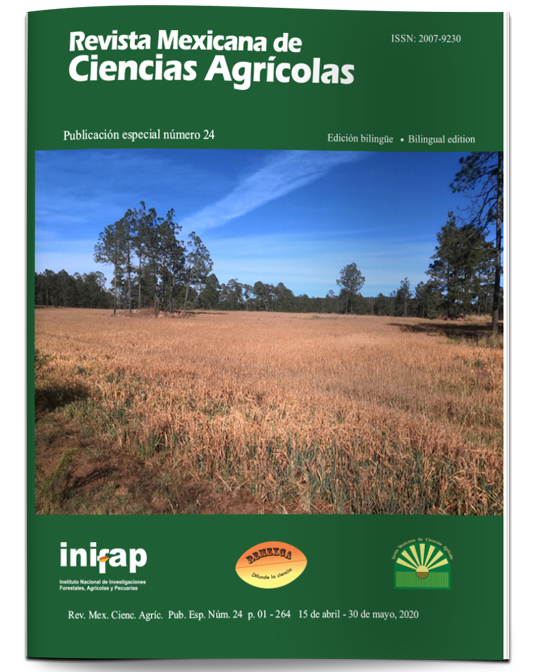Forage yield and morphological composition of native maize under semi-arid conditions
DOI:
https://doi.org/10.29312/remexca.v0i24.2358Keywords:
Zea mays, forage potential, genotypesAbstract
Environmental conditions in semi-arid areas limit the productivity of forage species used in animal feed; however, corn (Zea mays L.) has a wide adaptation to different environmental conditions of temperature, precipitation, altitude, soil, among others. The objective of the present study was to evaluate the yield and morphological composition of ten native corn genotypes, a hybrid and a synthetic variety, during the cycle Spring-Summer 2017. A randomized complete block experimental design was used, and an analysis of variance was performed; the means of the treatments were compared with the Tukey test. The variables evaluated were: yield of total dry matter (TDM), and by morphological component: leaf (lDM), stem (sDM), ear (eDM), panicle (pDM) and dead matter (dmDM), plant height (PH), number of leaves (NL), leaf length (LL), leaf width (LW) and the leaf/stem ratio (L/S). The highest and lowest TDM yield was obtained by the Raton×Tuxpeño Norteño genotype and the A6-069-B hybrid, with 8 888 and 3 113 kg DM ha-1, respectively. The highest height (180 cm) was obtained by the genotypes Raton×Tuxpeño Norteño and Olotillo×Tuxpeño. The largest number of leaves number was presented by the genotype Tuxpeño Norteño×Olotillo with 11.6. The largest leaf:stem ratio (2.1) was in the synthetic variety Breve Padilla. More research is needed on the improvement by recurrent selection of the Raton×Tuxpeño Norteño genotype to obtain a higher yield and nutritional value in corn fodder.
Downloads
Downloads
Published
How to Cite
Issue
Section
License
The authors who publish in Revista Mexicana de Ciencias Agrícolas accept the following conditions:
In accordance with copyright laws, Revista Mexicana de Ciencias Agrícolas recognizes and respects the authors’ moral right and ownership of property rights which will be transferred to the journal for dissemination in open access. Invariably, all the authors have to sign a letter of transfer of property rights and of originality of the article to Instituto Nacional de Investigaciones Forestales, Agrícolas y Pecuarias (INIFAP) [National Institute of Forestry, Agricultural and Livestock Research]. The author(s) must pay a fee for the reception of articles before proceeding to editorial review.
All the texts published by Revista Mexicana de Ciencias Agrícolas —with no exception— are distributed under a Creative Commons License Attribution-NonCommercial 4.0 International (CC BY-NC 4.0), which allows third parties to use the publication as long as the work’s authorship and its first publication in this journal are mentioned.
The author(s) can enter into independent and additional contractual agreements for the nonexclusive distribution of the version of the article published in Revista Mexicana de Ciencias Agrícolas (for example include it into an institutional repository or publish it in a book) as long as it is clearly and explicitly indicated that the work was published for the first time in Revista Mexicana de Ciencias Agrícolas.
For all the above, the authors shall send the Letter-transfer of Property Rights for the first publication duly filled in and signed by the author(s). This form must be sent as a PDF file to: revista_atm@yahoo.com.mx; cienciasagricola@inifap.gob.mx; remexca2017@gmail.
This work is licensed under a Creative Commons Attribution-Noncommercial 4.0 International license.



